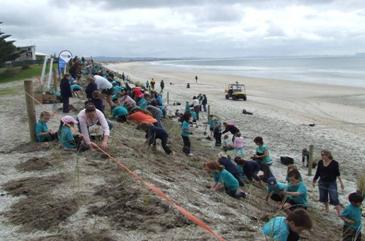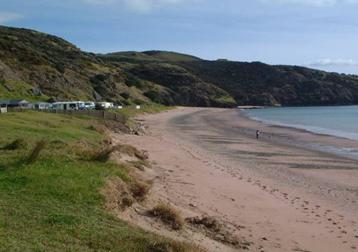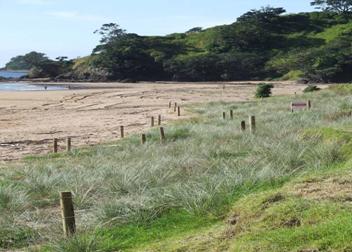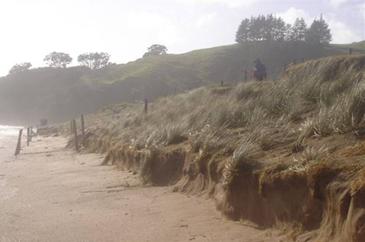CoastCare Programme
Within this section…
The NRC CoastCare programme was initiated in 2005. The aim of the programme is to enable communities to better understand coastal processes and initiate protection, restoration and enhancement of dune ecosystems through the establishment and resourcing of community-based CoastCare groups.
There are now over twenty CoastCare groups operating around the region (see summary of CoastCare projects below). During the winter of 2008, these groups planted approximately 13,000 spinifex, and 6,000 pingao plants to help restore dune habitats in their local environments. For more information on CoastCare groups operating in your area go to: http://www.nrc.govt.nz/Environment/Coast/Take-action/CoastCare/.

Photo: Planting Day at Waipu Cove
CoastCare Case Study – Tauranga Bay
Tauranga Bay is a typical example of a Northland east coast modified dune system. The beach frontage is designated as a District Council Coastal Reserve and a private campground is located on the frontage. The dunes themselves have been flattened in the past and native vegetation replaced with kikuyu.
The Tauranga Bay Community Association, with support from NRC and the Far North District Council (FNDC), designed and implemented a restoration strategy for dunes on the foreshore, adjacent to the reserve. In 2007, the group planted spinifex and pingao on the dunes, erected fences around the newly restored areas and constructed formal access ways, to direct foot traffic down to the beach, away from the new plants.
The plants thrived and sent out long runners (stolons) and although a severe storm swell in the winter of 2008 killed a number of plants, the new planting helped to bind the banks of the dunes and reduce erosion damage (see pictures below). The stolons left trailing over the steep face caused by the erosion will be able to take root and trap wind blown sand, in time restoring the dune profile.

Photo: Dunes at Tauranga Bay before restoration work (August 2002)

Photo: Dunes at Tauranga Bay after restoration (June 2008)

Photo: Erosion damage to dunes after storm (winter 2008)
|
Summary of CoastCare Group Activities 2007-2008 | ||||
|
|
Site Name |
Group Name |
District Council |
Key Activities |
|
1 |
Ahipara |
Ahipara CoastCare Group |
FNDC |
New group set up to undertake dune restoration. Also concerned with the issue of vehicles on beaches. |
|
2 |
|
Baylys Beach Society Inc |
KDC |
Formed with the aim of protecting the dunes from threats such as vehicles and to undertake dune restoration, including planting of native dune-binding plants. Over the last two years, the group has planted spinifex and pingao, and erected fencing to protect the dunes and newly planted areas. In July 2008, storms destroyed some of the fencing and eroded a section of the dunes. An NRC Environment Fund grant has been approved for repair work in these areas and to continue restoration work. |
|
3 |
Glinks Gully |
Glinks Gully Protection Society |
KDC |
The Society has undertaken weed control and planting of native trees in the back dune area and gully. The rear dune system has been degraded by bovine grazing & vehicle access. Over 2,000 native shrubs and trees have been planted to date. |
|
4 |
Kaimaumau |
Kaimaumau Coastal Reserve Group |
FNDC |
This group has undertaken weed and pest control in the dunes and adjacent wetland area, and planted appropriate native species. An NRC Environment Fund grant has been approved for continuation of this work. |
|
5 |
|
Karikari Peninsula Beach Care Group |
FNDC |
The group was formed in response to a growing number of coastal issues in the area. Careless use of vehicles on the beach and dunes was creating problems, including compromising the safety of other beach users and causing environmental damage to the fragile dune system. Strategies and projects are also being formulated that will assist in the conservation and restoration of the beach and surrounding significant conservation areas. The group is making a leaflet which will include information on the bay and will be distributed to all permanent and temporary residents. |
|
6 |
Marsden Point |
|
WDC |
The refining company planted approximately 1000 spinifex on World Environment Day. The company plan to continue this planting next winter. |
|
7 |
Mangawhai Spit |
|
KDC |
Work has been undertaken to stabilise the sand spit dunes, including erecting wind-break fences, planting native species, top dressing and rabbit control. It is hoped that these measures will reduce sand movement on the spit and so prevent further sedimentation of the estuary. The Society has also been successful in establishing a nursery, which has grown thousands of native pingao plants. These have been planted on the spit by volunteers from the community and members of the society. Spinifex plants are grown in Tauranga from seed collected on the spit. The planting, fencing and rabbit control regime are part of a longer-term programme which hopes to see the spit completely revegetated. Planting days are held annually. In 2008, approximately 5,000 spinifex and 10,000 pingao were planted. |
|
8 |
Oakura |
Oakura Foreshore Residents and Ratepayers Association |
WDC |
WDC are currently planning planting areas along the Oakura foreshore. The intention is to commence planting of Spinifex in the winter of 2009. |
|
9 |
Owahini |
|
WDC |
The main issues on this beach are vehicles driving unsafely in the presence of other beach users and parked vehicles obstructing access to the beach. Some spinifex has been planted at the end of Owahini bay and more will be planted during the 2009 winter. |
|
10 |
|
|
WDC |
The Ocean Beach Protection Society aims to work with nature to restore and protect biodiversity in the area. To date, species planted at the back of the dunes include manuka, kanuka, cabbage tree, flax, coprosma and pohutukawa. Weed and pest control have also been undertaken. The group plans to continue planting work, including revegetation of the sand dunes with native sand-binding plants, such as pingao and spinifex. |
|
11 |
Omapere - Opononi |
|
FNDC |
Hokianga residents established the incorporated society to help NRC and FNDC manage coastal erosion along the Omapere-Opononi foreshore. A number of reports and studies have been undertaken to investigate the various options for erosion control along the Omapere-Opononi foreshore. The latest report is the ‘Omapere-Opononi Dune Restoration Strategy’ which brings together the previous studies and reports. The strategy recommends dune restoration, by reshaping and planting with native sand-binding plants, as the most sustainable means of erosion control. A public meeting will be held in October 2008 to consult with the local community. |
|
12 |
Omamari (Ripiro) |
Hua Rakau Ki Omamari Trust |
FNDC |
The Omamari beach group was established in 1997 in response to declining numbers of pingao, godwit and inanga populations in the local area. The group started by collecting, growing and planting pingao seedlings on the sand dunes. They also undertook pest control, erected signage, and constructed a manuka wind-break. The group then focused on restoring the backdune area, particularly next to the Omamari stream, by planting pohutukawa and harakeke. In addition, some pest plants, such as alligator weed, have been cleared and designated walkways created. |
|
13 |
One Tree Point |
Pyle family |
WDC |
Planting of spinifex and pingao for erosion control. |
|
14 |
Owhata (Herekino) |
Owhata Ahu Whenua Trust |
FNDC |
A ‘shade house’ has been built, with money from NRC’s Environment Fund. This is being used to propagate pingao and other native plants, which will be planted along the foreshore to protect the peninsular from erosion. To date, a large number of native plants and trees have already been planted on the peninsula and foreshore. |
|
15 |
Ruakaka |
|
WDC |
The Trust intends to protect and enhance indigenous flora, fauna and habitats in the local area. The Trust has been working on an ongoing project to restore the dune lake at Ruakaka (with assistance from the NRC Environment Fund). They are also undertaking pest control in the area adjacent to the Ruakaka Wildlife Refuge and will be collecting spinifex seed to propagate and plant. |
|
16 |
Taipa |
|
FNDC |
This is a joint project between the school and local community. To date, 800 spinifex have been planted along the foreshore, mainly in front of the school. Four wooden ‘sand ladders’ have also been built to provide designated access down to the beach, thereby reducing footpath erosion. Further spinifex and pingao planting will take place in the winter of 2008, using money from the NRC Environment Fund. School students are also designing signs to encourage people to keep off the dunes. |
|
17 |
Tapeka |
Tapeka Ratepayers Group |
FNDC |
This project was initiated by residents who are concerned about severe erosion damage along this stretch of coast. Permission was granted to dig a channel directly out to sea. The bank was then reshaped and planted out with 600 spinifex. Sand ladders have been put in place to facilitate pedestrian access to the beach and discourage people from walking on the dunes. |
|
18 |
|
|
FNDC |
Taupo bay is a favourite dotterel nesting area, however before the group formed, very few chicks were surviving. Intensive pest control has been undertaken by the group and this year, eight young dotterel were recorded. Vehicles are now prohibited from the beach, which has also helped the dotterel population, and a large amount of planting has been undertaken in the bay. |
|
19 |
|
|
FNDC |
A sub-committee of the Tauranga Bay Community Association has been formed to work on CoastCare activities and the protection of nesting dotterels from inappropriate vehicle use on the beach. To date, over 3000 spinifex have been planted along the foreshore adjacent to the FNDC reserve. Temporary fencing has also been erected around the dotterel nesting area. Dotterel and oyster catcher numbers have increased as a result. Spinifex has established well. In April, spinifex planted the previous August had sent out 3m runners. Severe storm surges in July eroded the developing dune and caused the loss of a number of plants. However, the majority of plants survived and will help with the restoration of the dunes. |
|
20 |
Te |
Te |
FNDC |
This group was formed by local residents to protect the beach from vehicle damage and enhance the natural beauty of the bay. Spinifex and pingao are being propagated from seed collected from the bay. These will be planted out in winter 2009. The group have also planted native coastal shrubs and plants in the reserve, with money received from FNDC. |
|
21 |
Waipapakauri |
Waipapakauri Coastal Care Group |
FNDC |
The group was formed to restore the damaged dune system near the Waipapakauri ramp onto Prior to the July storms, the planted spinifex was growing well. However, the storms wiped out a large section of the dunes north of the ramp. The planted area south of the ramp survived relatively untouched. Planting will continue in 2009 to fill in the gaps in the planted area. |
|
22 |
Waipu Cove |
Waipu Cove CoastCare |
WDC |
This group was formed to work towards restoring the dune system at Waipu. However, winter storms eroded the bank in front of the surf club and caused the loss of the majority of the planted. More plants are due to be planted in August 2008 to replace those lost. |
|
23 |
Whangaruru |
Whangaruru Coastal Community Group |
WDC |
This recently formed group aims to tackle a range of issues in the Whangaruru harbour and catchment. The group plans to undertake dune planting in the winter of 2009. |
